Hey audio fans! Are you searching for that classic bookshelf speaker look but crave the convenience of modern wireless technology?
It seems bookshelf speakers might be making a comeback, and Audioengine is leading the charge with their A5+ Wireless Speakers. Building on the success of the highly-regarded A5 series, these speakers aim to deliver high-fidelity audio without the clutter of excessive wires.
Audioengine has a solid reputation for quality home audio gear, so let’s dive into what makes the A5+ Wireless a compelling option for your desk, living room, or studio setup. Could these be the premium Bluetooth speakers for desktop you’ve been searching for?
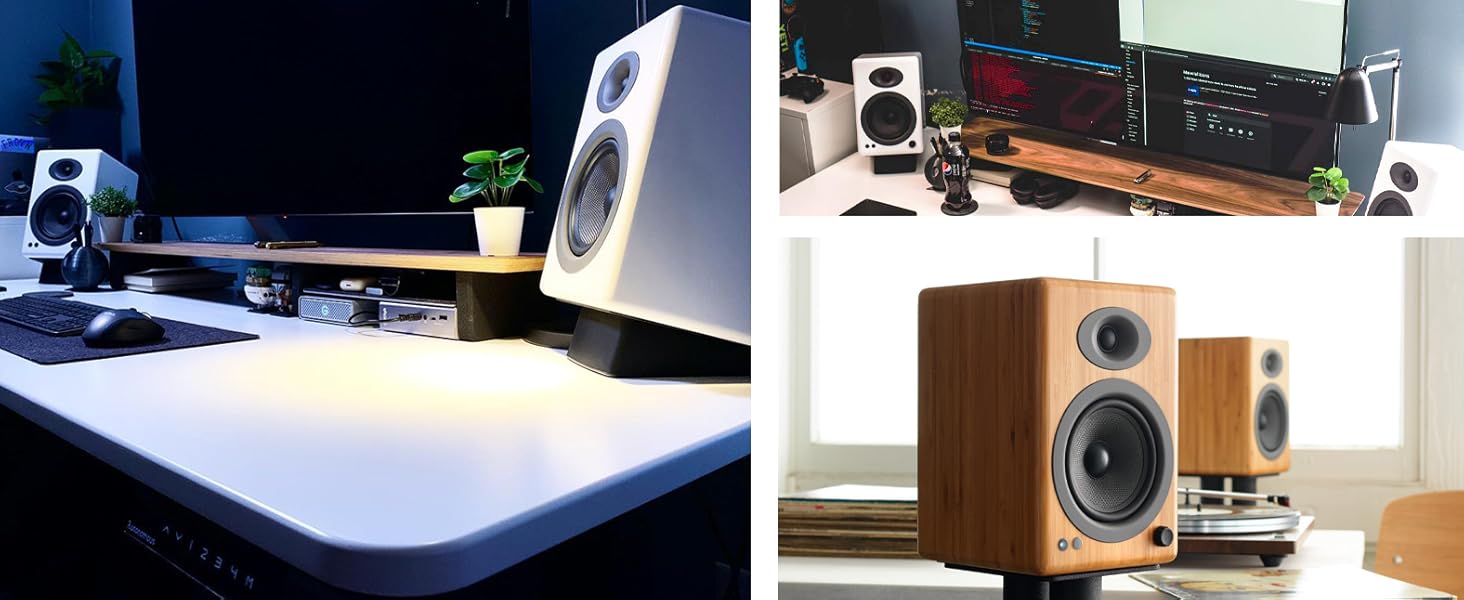
What’s Included? Getting Started
Audioengine ensures you have (almost) everything you need right out of the box. The unboxing experience feels premium, with the speakers arriving protected in nice microfiber bags – a thoughtful touch for keeping them pristine or even for transport.
Here’s what you’ll find inside: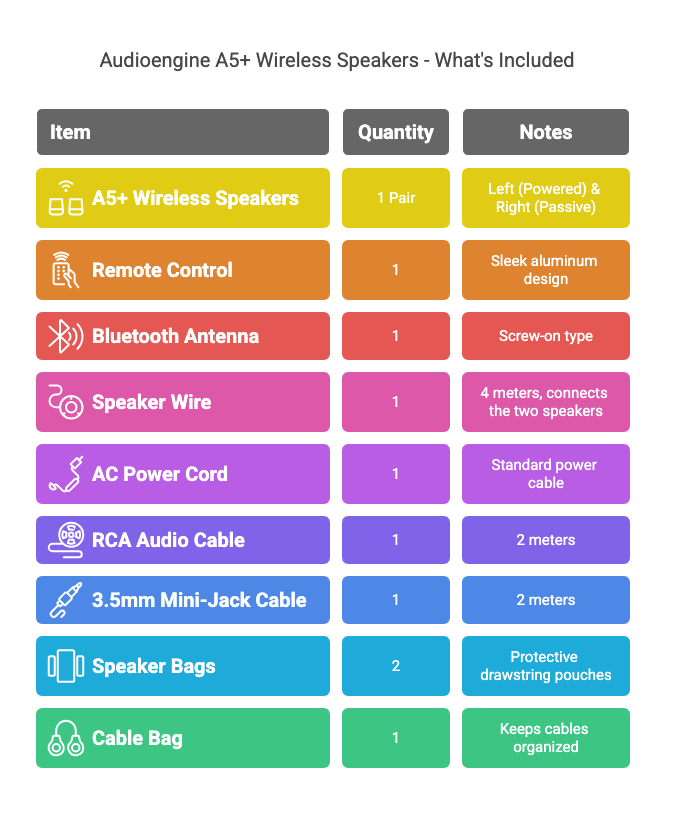 The inclusion of good-quality cables is definitely appreciated, as it means you can get set up without immediate extra purchases.
The inclusion of good-quality cables is definitely appreciated, as it means you can get set up without immediate extra purchases.
Read: Edifier HECATE G1500 Review: Your Guide to Stylish & Versatile USB/Bluetooth Desktop Gaming Speakers
Audioengine A5+ Wireless: Key Specifications
Let’s look at the technical details :
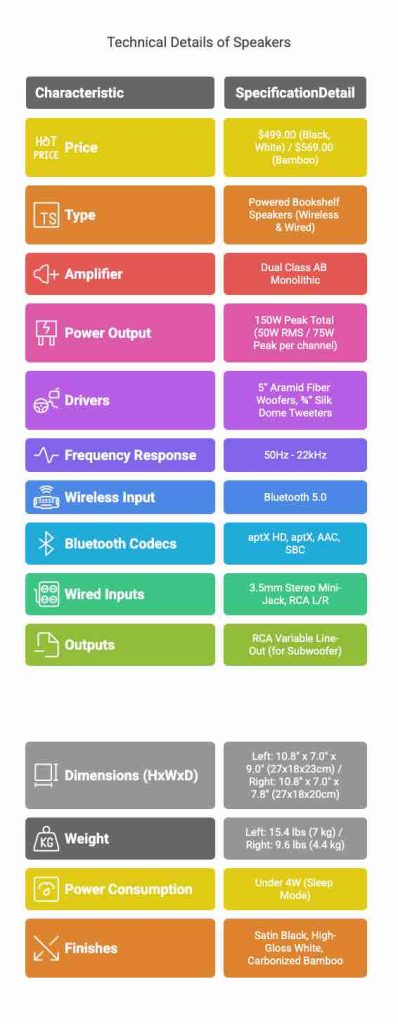
Design and Build Quality: Classic Looks, Modern Feel
The A5+ Wireless speakers boast a classic bookshelf design with beautifully rounded corners that give them a modern, elegant aesthetic. One striking detail is the lack of any logos on the front, top, or sides, resulting in a wonderfully clean and minimalist look that blends well into various decors.

The cabinets are handcrafted from solid 1/2-inch thick MDF wood, not plastic, contributing significantly to both the sturdy feel and the audio performance. Available finishes include a smooth satin black, a stunning high-gloss white and a premium carbonized bamboo option for a bit extra. Everything feels exceptionally well put-together – the cabinets are rigid, back panels are securely fastened, and the connectors feel high-quality.
Read: Edifier HECATE G1500 MAX Review: Level Up Your Audio Experience
The left speaker is the “brains” of the operation, housing the amplifier, connections, a subtle status light, an IR receiver for the remote, and a satisfyingly tight volume knob that also doubles as a sleep button (push to sleep). The right speaker is passive, simply housing the drivers and the connection points for the included speaker wire.
A massive heatsink on the back of the left speaker keeps the dual class AB analog amplifier cool during operation. This analog amp choice is noted as important by reviewers, often favored by audiophiles over more common digital amps for its potential sound characteristics.
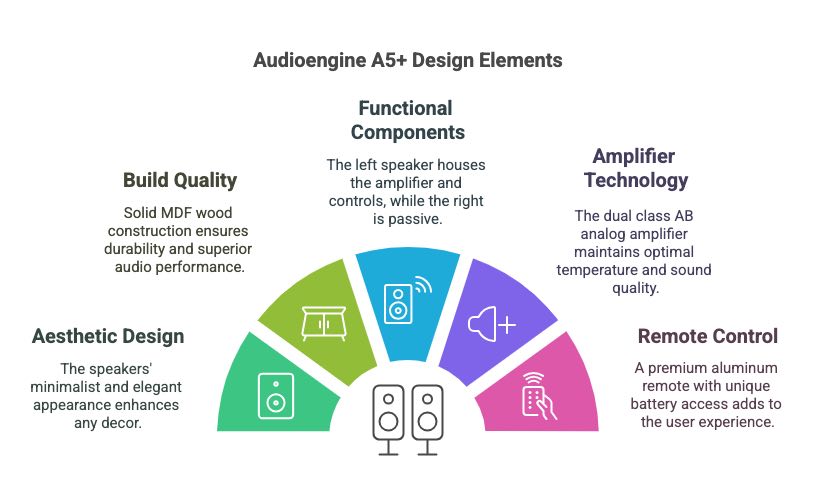
Even the remote control feels surprisingly premium. It’s milled from a single piece of brushed aluminum with chamfered edges. While the buttons themselves feel slightly less premium, the unique magnetic mechanism for accessing the coin cell battery (using a SIM tool or paperclip) reveals impressive attention to detail.
Setup and Connectivity: Wired or Wireless, Your Choice
Setting up the A5+ Wireless is straightforward.
- Connect the Speakers: Use the included 4-meter speaker wire with banana plugs to link the left (powered) speaker to the right (passive) speaker via the high-quality binding posts on the back of each.
- Connect Power: Plug the AC power cord into the back of the left speaker and into a wall outlet.
- Connect Antenna: Screw the Bluetooth antenna onto the designated port on the left speaker’s back panel.
- Choose Your Source:
- Wireless (Bluetooth): Flip the power switch on the back of the left speaker. Press the “Pair” button near the antenna. The speakers should appear in your device’s Bluetooth menu (phone, tablet, computer). Select them to pair. No complex apps or Wi-Fi setup needed!
- Wired: Connect your source (computer, DAC, turntable pre-amp, etc.) using either the 3.5mm mini-jack input or the RCA L/R inputs on the left speaker with the provided cables or your own.
An interesting point is that wired inputs can be used simultaneously with Bluetooth. There’s no input selector switch. This could be convenient, but also means you might accidentally play two sources at once if you’re not careful.
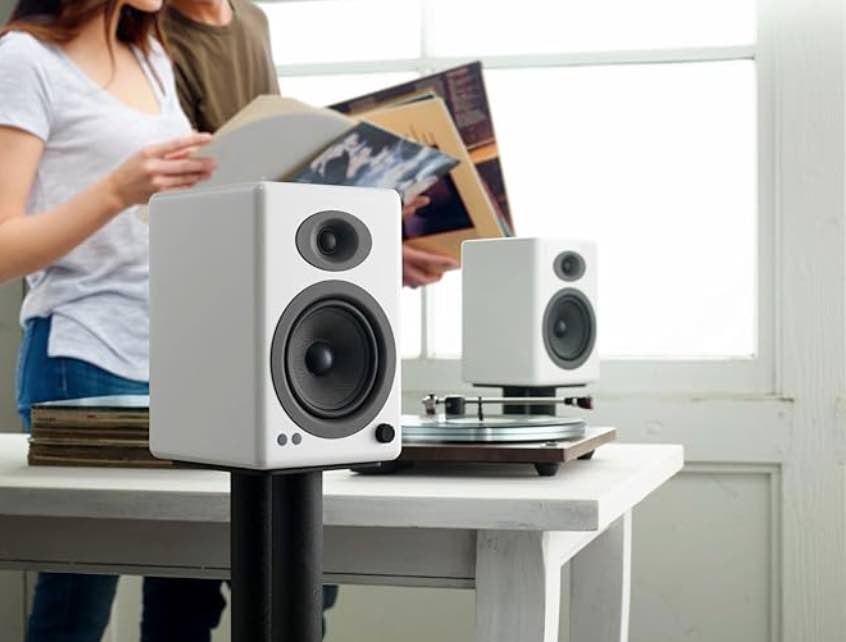
Important Note on Placement: Like most traditional bookshelf speakers (unlike many soundbars), placement matters for optimal sound. Reviewers suggest placing them spread apart for good stereo imaging, ideally at ear level for the listener. Using wedge-style stands can help angle the drivers correctly, especially for desktop use. Giving them a little space behind (not crammed onto a bookshelf) is also recommended.
Read: Razer Nommo V2 X Review: Big Sound, Minimalist Style for Your Gaming PC
Sound Quality Breakdown: Accurate, Engaging, and Powerful
This is where the A5+ Wireless truly shines, according to all reviewers. They deliver a sound signature aimed at audio purists but enjoyable for everyone.
Overall Signature: The sound is described as remarkably flat and balanced, meaning it doesn’t artificially boost the bass or treble excessively. It’s accurate and natural, revealing details and textures in your music. While “flat” can sometimes sound clinical, reviewers note these speakers still sound interesting, fun, and engaging, especially when turned up. They offer a “breath of fresh air” compared to overly processed speakers.
Bass Performance: For their size, the bass is surprisingly strong, punchy, and precise. The custom 5-inch aramid fiber woofers deliver palpable thump without sounding slow or boomy. It can handle aggressive electronic music and metal well. However, it focuses on accuracy rather than overwhelming sub-bass rumble (the kind that shakes the room). Bass is noted as being a bit weak at very low listening volumes but comes alive as you increase the volume. If you crave deep, floor-shaking lows (below ~50-60Hz), the RCA variable output makes adding Audioengine’s S8 or another powered subwoofer simple.
Midrange Clarity: This is highlighted as a standout feature, especially for a speaker with monitoring roots. The midrange is very clear, crisp, detailed, and slightly warm, with excellent timing. Vocals (both male and female) sound sweet and natural. It excels at revealing nuance and texture in recordings, much like high-fidelity headphones.
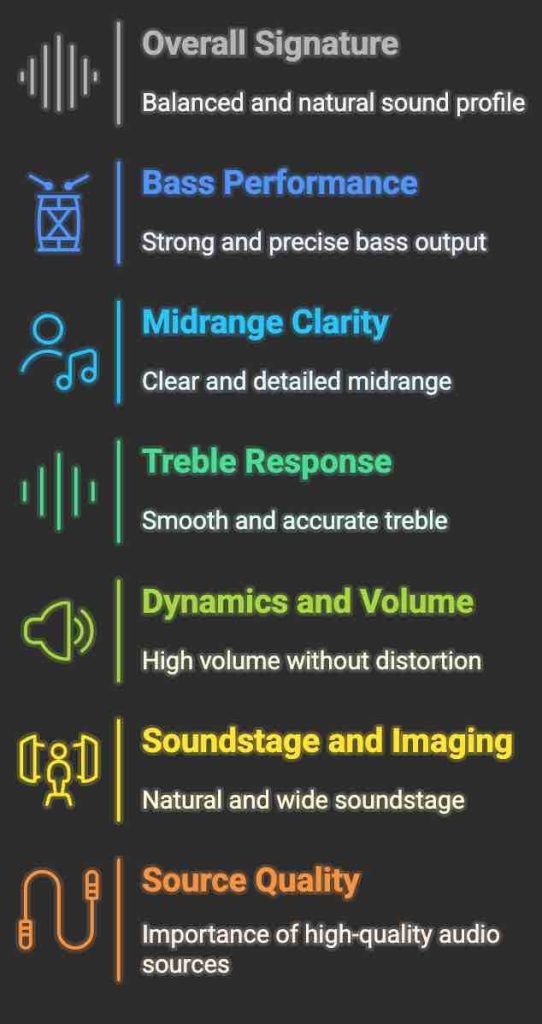
Treble Response: Thanks to the ¾-inch silk dome tweeters, the treble is silky smooth, sharp, and accurate but never harsh, sibilant, or grating. It provides enough high-frequency presence for detail without causing fatigue, making them great for long listening sessions and forgiving of older or less-than-perfect recordings.
Dynamics and Volume: These speakers can get incredibly loud without distortion. They easily fill a medium-sized room to levels where you can’t shout over them, while maintaining clarity and sharpness across the frequency range. Dynamics are well-represented, making music and even gaming sound impactful.
Soundstage and Imaging: The A5+ Wireless creates a natural and well-rounded soundstage with good width and depth. Instrument separation is clear, allowing you to pinpoint different elements in the mix. Importantly, the soundstage remains consistent even in nearfield (desktop) setups or when placed relatively close together.
Source Quality Matters: Being analog speakers, the quality of your source signal is important. While they’ll sound good with average devices, a quality DAC (like the Creative Sound BlasterX G5 or connecting via aptX HD Bluetooth) will allow them to perform at their best. There are no digital inputs like Optical or USB Audio directly on the speakers.
Wireless Performance: High-Quality Bluetooth Made Simple
Audioengine implemented Bluetooth 5.0 exceptionally well.
- Ease of Use: Pairing is dead simple, as described in the setup section.
- Signal Strength: The connection is robust and stable, with reviewers experiencing no dropouts, even near Wi-Fi routers.
- Audio Quality: Support for aptX HD, aptX, AAC, and SBC codecs is key. aptX HD allows for “better-than-CD quality” wireless streaming (up to 24-bit/48kHz). Most users likely won’t hear a significant difference between a high-quality wired connection and aptX HD Bluetooth. Even standard aptX offers a solid wireless experience. The internal 24-bit upsampling D/A converter further ensures high-quality playback over Bluetooth.
- Latency: Bluetooth implementation is good enough for watching videos without noticeable lip-sync delay.
Minor Gripe: One reviewer noted that the speakers automatically connect to the last paired device when powered on. This can be slightly annoying if you come home and your phone auto-connects, interrupting its own audio output. A manual connection option would have been preferred by that reviewer.
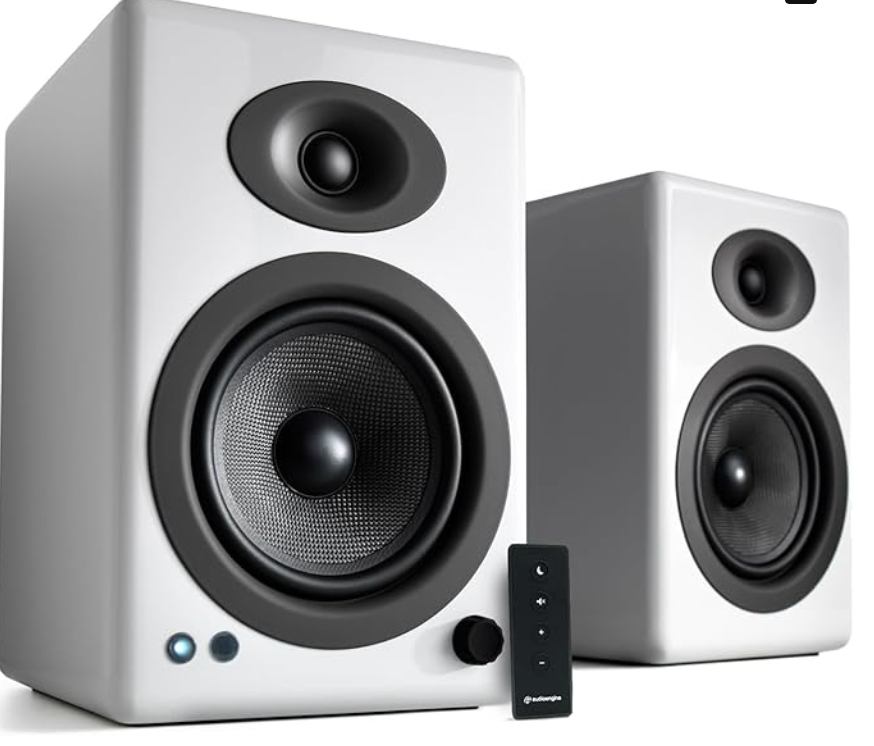
The Minor Quibbles (Potential Downsides)
No product is perfect, and reviewers pointed out a few minor drawbacks:
- Bass at Low Volume: Can sound a bit thin at very quiet listening levels.
- Sub-Bass: While bass is good, true sub-bass fanatics might still want a dedicated subwoofer.
- Bluetooth Auto-Connect: Can be inconvenient for some users (as mentioned above).
- No Input Switch: Simultaneous inputs might lead to accidental sound blending.
- Limited Remote: Only controls Volume, Mute, and Sleep – no track control or source selection.
- No Digital Inputs: Lack of Optical or USB audio input might require adapters or a receiver for some sources (like TVs or game consoles).
- Analog Nature: Sound quality can be influenced by the source device’s output quality.
- Desktop Placement: Require stands for optimal ear-level listening on a desk and take up more space than typical computer speakers.
Who Should Buy the Audioengine A5+ Wireless?
Based on the reviews, these speakers are ideal for:
- Music lovers seeking high-fidelity sound with the convenience of wireless streaming.
- Audiophiles who appreciate a balanced, accurate sound signature and quality components like analog amps and custom drivers.
- Users wanting versatile speakers for music, desktop use, gaming, or even light studio monitoring.
- Individuals who value excellent build quality, premium materials, and clean aesthetics.
- Anyone looking for a simple, reliable Bluetooth speaker system without complex apps or network setups.
- People willing to invest in a long-lasting, high-performance audio solution that avoids the compromises often found in “smart” speakers (like DSP or voice assistant integration).
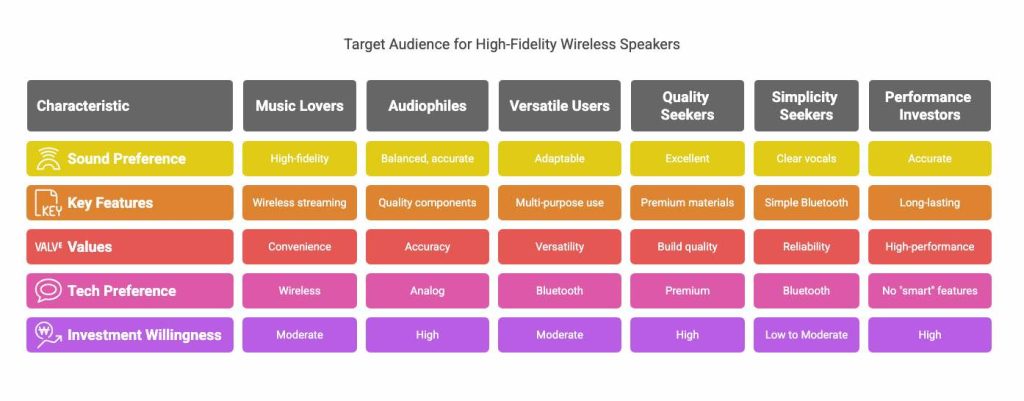
Value and Conclusion: A Worthwhile Investment in Sound
Priced at $499 (or $569 for bamboo), the Audioengine A5+ Wireless aren’t budget speakers, but they offer tremendous value for what you get. They represent a significant step up from typical computer speakers or basic Bluetooth units.
You’re investing in superb, balanced audio performance, exceptional handcrafted build quality, reliable and high-quality wireless connectivity with aptX HD, and a timeless, elegant design. The attention to detail, from the custom drivers and analog amplifier to the premium remote and included accessories, is evident.
While they might require a subwoofer for the absolute deepest bass extension and lack some features like digital inputs or complex app control, their core function – delivering fantastic sound effortlessly – is executed brilliantly. They are easy to set up, easy to use, and sound amazing across various genres and use cases.
If you care about audio quality and want a set of powered bookshelf speakers that blend classic hi-fi principles with modern wireless convenience, the Audioengine A5+ Wireless speakers are an outstanding choice and come highly recommended. They prove that convenience doesn’t have to mean sacrificing sound quality. Ready to bring bookshelf speakers back into style? The A5+ Wireless makes a very strong case!



